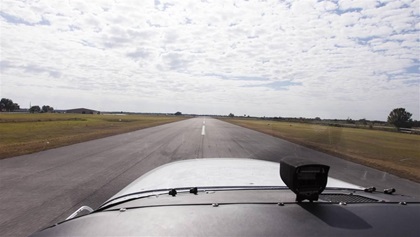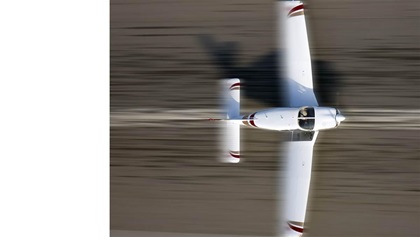From the ground up
Use taxiing to improve your landings
By Dan K. Dyer
Pilots are always looking to improve landings. Most people think improvements can only be gained by repeated landing practice, but landing insights can be gained from other phases of flight as well. At San Carlos Flight Center, we teach ways to improve student landings with lessons at altitude, learning attitude control; lessons of stable, controlled takeoffs; and, somewhat surprisingly, with taxiing lessons. With the right approach, your time on the taxiway can be a great place to test and improve the skills you use during landing.

Sight picture: This is flat
So much of landing is visual. Your eyes judge the runway size, shape, and angle, but you also see how high the nose is, what bank the airplane makes with the horizon, and whether the nose points left or right. Landing is all about visual cues. During landing practice, we learn to see and interpret those cues, but you can also get exposure to these visual cues on the taxiway.
The next time you are taxiing, slow down and drink in the sight picture. The first thing to notice is this is flat. While taxiing, all wheels are on the ground. In tricycle-gear airplanes, that taxiway centerline you see out in front of you looks the way it does because the airplane is in a flat attitude. In most aircraft, you can see a long line of taxiway ahead of you. That is what flat looks like. On landing, if you can see a long line of runway centerline ahead of you, you are flat. Keep flaring. Keep slowly adding aft elevator pressure until the nose rises to block some of that runway. That’s the only way to know the landing impact will be absorbed solely by the main landing gear.
You can use the time taxiing for more research. Many aircraft have compressible nosewheel struts. Find a long taxiway in a clear area without other traffic or hazards. Extend the flaps, add a hint of power, and pull aft on the controls, keeping the nosewheel touching the ground with the nosewheel strut extended.
Notice the sight picture again. There may be less view of the taxiway ahead, but there is still a lot that you can see. This is also what flat looks like. All wheels are on the ground. If you see this sight picture the next time you are flaring, you are still flat. Keep flaring. Your landing sight picture will be higher than this sight picture, too, if you want to protect the nose.
Sight picture: This is parallel
Although instructors stress the importance of being aligned with the centerline for touchdown, some students have a difficult time recognizing what parallel looks like. Engine cowlings are curved. The front control panel is often curved. Windshields are curved and can create parallax.
The best place to learn what sight picture is parallel is on the taxiway. If you start on the taxiway centerline, roll forward, and remain on the centerline, you must be parallel. Use the time to check out physical cues on your airplane that can help you. Cowling rivets, defrost vents, marks on the dashboard, anything can help be a reference for seeing what parallel looks like. It’s a lot easier to learn these cues while taxiing than in a landing flare without the wheels rolling on the ground.
Last, notice how much better you are at staying on the centerline if your eyes look far ahead down the taxiway. Keeping your eyes focused farther down the runway or taxiway lets you detect subtle changes in heading far more easily than if you are looking very closely in front of the nose. It’s true for taxiing. It’s especially true for landing.
Rudder is active
Nosewheel steering is an active process. It never ends. At our flight school, we tell students, “There is no way to win at taxiing,” which means there is no way to get the rudder just right and leave it there. There is no way to stop playing with the rudder pedals. Sometimes new students think that moving their feet a lot means they are not good pilots, and that their feet will stabilize as they get more experience. Nope. Every gust of wind, every rise or drop in taxiway slope, every centerline light or reflector, and even the texture of the painted centerline can catch the nosewheel and take the airplane off center. Your feet and nosewheel steering must account for and correct every one of these. Get used to it.
The next time you are in the taxiway laboratory, focus on the movement of your feet. Notice how active your feet have to be while taxiing. This is exactly how active your feet should be while landing. Every gust, every movement of the aileron, and every power adjustment can yaw the nose off parallel. Only your feet can correct for this. Stay as light and playful on the rudder during roundout, flare, and touchdown as you are while taxiing. If you use your taxiway time and practice being aware of how active and automatically your feet are while taxiing, you’ll be more likely to give them permission to operate the same playful way on landing. Active feet will get you parallel, and keep you parallel, even during the ground roll.
Always Use Crosswind Taxi Technique
Crosswind landings are always a concern for pilots, and there is something you should do every time you taxi that will make your crosswind landings better: crosswind taxi technique. Bank into a headwind. Dive away from a tailwind. Those memory aids guide you to make the correct elevator and aileron inputs when taxiing in strong winds.
Proper crosswind taxi technique helps to stop the wind from flipping the aircraft over during surface movement.
While taxiing, challenge yourself to use full crosswind taxi technique at all times—even when winds are light. Why? First, it will force you to learn crosswind taxi technique, which means you won’t have to reach deep into a fading memory to protect yourself when you suddenly find yourself in strong winds. Second, it will make you more comfortable using full aileron deflection while the airplane is moving. Most pilots lose accuracy during crosswind landings when a wheel touches and they unconsciously relax aileron deflection because it feels strange. This is improper procedure and can be dangerous. Teach yourself while taxiing that full aileron deflection is not strange, and is sometimes necessary.
The third reason is that crosswind taxi technique forces your brain to disconnect the operation of your hands from the operation of your feet. Feet have a job to do. They actively keep the airplane pointing down the taxiway or runway. Hands have a different job: maintaining a stable bank angle for landing. If your brain subconsciously always links hand movement with feet movement, they interfere with each other.
As an instructor, I watch the control yoke while a student is taxiing. If every time the pilot uses right rudder pressure to steer the nose right and his or her hands unconsciously steer the yoke right, I know we are going to have a problem on landing. The controls need to be split.
Feet should be active keeping the airplane parallel; hands should be calm and maintaining a stable bank angle. It’s the pilot equivalent of patting your head and rubbing your stomach. Crosswind taxi technique forces your brain to let your feet and hands learn to do different things at the same time.
Fix it Now
The last thing that taxiing can teach you about landing is the value of assertiveness. If you make a correction as soon as it is needed, the change you make can be small. If you hesitate to make the necessary correction, you’ll need to make a much bigger correction. You can see that while taxiing. Small, prompt corrections keep you on the centerline. Delayed corrections require bigger movements and result in a zigzag that destabilizes everything.
The same is true for landing. On final approach, if the airplane needs to slide left or right a bit, fix it now. Making a tiny change in bank as soon as you notice it will save you from having to make a giant bank change at the last minute, destabilizing your approach. If something yaws the nose left or right of parallel, fix it now. The sooner you notice and make a small correction, the more stable and safe your landing will be.FT
CFI Dan Dyer lectures, develops flight training materials, and runs San Carlos Flight Center in the San Francisco Bay Area.
Email [email protected].
 Taxi tips
Taxi tips JARGON: FLARE
JARGON: FLARE

